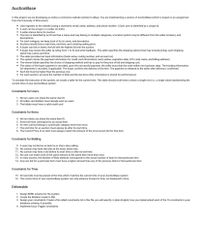
Database System Concepts
7th Edition
ISBN: 9780078022159
Author: Abraham Silberschatz Professor, Henry F. Korth, S. Sudarshan
Publisher: McGraw-Hill Education
expand_more
expand_more
format_list_bulleted
Concept explainers
Question
Implement the 16 constraints in a

Transcribed Image Text:AuctionBase
In this project, we are developing an online e-commerce website (similar to eBay). You are implementing a version of AuctionBase (which is based on an assignment
from the University of Wisconsin).
User registers to the website (using a username, email, name, address, and phone number. ) Each user is identified by a unique id.
A user can be a buyer or a seller (or both).
• A seller places items for Auction.
The item is identified by an ID and has a name and may belong to multiple categories, a location (which may be different from the seller location), and
descriptions.
• For each category, we keep track of its id, name, and description.
• Auctions would have a start time, end time, and a starting asking price.
• A buyer can bid on items, the bid with the highest bid win the auction.
A buyer may review the seller (a rating from 1 to 5) and write feedback. -The seller specifies the shipping options that may include pickup, each shipping
option has a price and time.
The seller provides her bank information (bank name, routing number, and account no).
The system stores the payment information for credit card information( card number, expiration date, CCV code, name, and billing address).
The winner bidder specifies her choice of shipping method and has to pay for the price of bid and shipping cost.
The status of the buyer payment is recorded, upon the successful payment, the seller must ship the order within two business days. The tracking information
(of shipment) is recorded, if applicable. The buyer confirms the delivery of the item. The payment is released to the seller after delivery is confirmed.
• Each bid must be higher than the previous one.
• For each auction, we store the number of bids and the last price (this information is stored for performance).
To simulate the execution of the system, we create a table for the current time. This table should at all times contain a single row (i.e., a single value) representing the
current time of your AuctionBase system.
Constraints for Users
1. No two users can share the same User ID.
2. All sellers and bidders must already exist as users.
3. The bidder must have a valid credit card
Constraints for Items
4. No two items can share the same Item ID.
5. Every bid must correspond to an actual item.
6. An item cannot belong to a particular category more than once.
7. The end time for an auction must always be after its start time.
8. The Current Price of an item must always match the Amount of the most recent bid for that item.
Constraints for Bidding
9. A user may not bid on an item he or she is also selling.
10. No auction may have two bids at the exact same time.
11. No auction may have a bid before its start time or after its end time.
12 No user can make a bid of the same amount to the same item more than once.
13. In every auction, the Number of Bids attribute corresponds to the actual number of bids for that particular item.
14. Any new bid for a particular item must have a higher amount than any of the previous bids for that particular item.
Constraints for Time
15. All new bids must be placed at the time which matches the current time of your AuctionBase system.
16. The current time of your AuctionBase system can only advance forward in time, not backward in time.
Deliverable
1. Design EERD schema for the system.
2. Create the Relation model in SQL
3. Design your constraints: Create a file called constraints.txt in this file, you will specify, in plain English, how you implemented each of the 16 constraints in your
database schema, if possible.
4. Implement your Trigger constraints.
Expert Solution
This question has been solved!
Explore an expertly crafted, step-by-step solution for a thorough understanding of key concepts.
This is a popular solution
Trending nowThis is a popular solution!
Step by stepSolved in 2 steps

Follow-up Questions
Read through expert solutions to related follow-up questions below.
Follow-up Question
what are the sixteen constraints
Solution
by Bartleby Expert
Follow-up Questions
Read through expert solutions to related follow-up questions below.
Follow-up Question
what are the sixteen constraints
Solution
by Bartleby Expert
Knowledge Booster
Learn more about
Need a deep-dive on the concept behind this application? Look no further. Learn more about this topic, computer-science and related others by exploring similar questions and additional content below.Similar questions
arrow_back_ios
arrow_forward_ios
Recommended textbooks for you
 Database System ConceptsComputer ScienceISBN:9780078022159Author:Abraham Silberschatz Professor, Henry F. Korth, S. SudarshanPublisher:McGraw-Hill Education
Database System ConceptsComputer ScienceISBN:9780078022159Author:Abraham Silberschatz Professor, Henry F. Korth, S. SudarshanPublisher:McGraw-Hill Education Starting Out with Python (4th Edition)Computer ScienceISBN:9780134444321Author:Tony GaddisPublisher:PEARSON
Starting Out with Python (4th Edition)Computer ScienceISBN:9780134444321Author:Tony GaddisPublisher:PEARSON Digital Fundamentals (11th Edition)Computer ScienceISBN:9780132737968Author:Thomas L. FloydPublisher:PEARSON
Digital Fundamentals (11th Edition)Computer ScienceISBN:9780132737968Author:Thomas L. FloydPublisher:PEARSON C How to Program (8th Edition)Computer ScienceISBN:9780133976892Author:Paul J. Deitel, Harvey DeitelPublisher:PEARSON
C How to Program (8th Edition)Computer ScienceISBN:9780133976892Author:Paul J. Deitel, Harvey DeitelPublisher:PEARSON Database Systems: Design, Implementation, & Manag...Computer ScienceISBN:9781337627900Author:Carlos Coronel, Steven MorrisPublisher:Cengage Learning
Database Systems: Design, Implementation, & Manag...Computer ScienceISBN:9781337627900Author:Carlos Coronel, Steven MorrisPublisher:Cengage Learning Programmable Logic ControllersComputer ScienceISBN:9780073373843Author:Frank D. PetruzellaPublisher:McGraw-Hill Education
Programmable Logic ControllersComputer ScienceISBN:9780073373843Author:Frank D. PetruzellaPublisher:McGraw-Hill Education

Database System Concepts
Computer Science
ISBN:9780078022159
Author:Abraham Silberschatz Professor, Henry F. Korth, S. Sudarshan
Publisher:McGraw-Hill Education

Starting Out with Python (4th Edition)
Computer Science
ISBN:9780134444321
Author:Tony Gaddis
Publisher:PEARSON

Digital Fundamentals (11th Edition)
Computer Science
ISBN:9780132737968
Author:Thomas L. Floyd
Publisher:PEARSON

C How to Program (8th Edition)
Computer Science
ISBN:9780133976892
Author:Paul J. Deitel, Harvey Deitel
Publisher:PEARSON

Database Systems: Design, Implementation, & Manag...
Computer Science
ISBN:9781337627900
Author:Carlos Coronel, Steven Morris
Publisher:Cengage Learning

Programmable Logic Controllers
Computer Science
ISBN:9780073373843
Author:Frank D. Petruzella
Publisher:McGraw-Hill Education